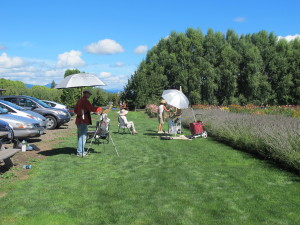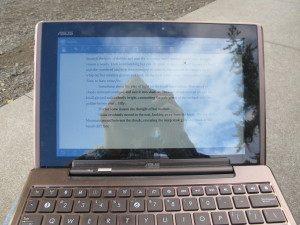Even the best-trained horses can come up with a training hole, especially if their experiences have been pretty much in the arena. While I’ve been pretty firm about Mocha being able to open gates, step over objects (or jump), and walk/trot through water, I’ve not thought much about walking her downhill. There’s a little downhill driveway section that goes past the barn and I’d not thought much about it. Mocha had been reluctant to go down it before and I laid that to barn sourness, focusing on other training things in past summers.
This summer I decided it was time to change that state of affairs. I figure every saddle horse needs a few basics, no matter if most of the time they work in an arena, and one of them is walking downhill under saddle. Not every horse is cut out to be a trail horse, but there really wasn’t a reason in my mind that an athletic horse like Mocha couldn’t do it.
Mocha had different opinions on the subject. She’d start down, then stop, fuss, and either sidepass or back up, but she would NOT go down that hill. Because we were working on blacktop, my priority was to figure this out without freaking her out and getting both of us hurt.
So I broke apart the task, much as I would do as a special education teacher. Antecedent, behavior, consequence. What was the triggering factor or factors? What behaviors was she showing in her resistance? Why was she objecting? Balance, footing, something spooking or frightening her, a combination of that, confusion, worried, or simply stubborn Idontwanna!
I rejected Idontwanna right off. When Mocha shows those moments of resistance where it is a difference of opinion in what she wants to do from what I want to do, that usually comes up in pattern or rail work. Loose rein hacking doesn’t get Idontwanna. She doesn’t balk, usually, she starts speeding up in Idontwanna. A balk during a hack is something else, and there’s a reason for it other than overruling rider judgement.
Spook or fear got ruled out because she was relaxed until we started going downhill. She might have been a bit anxious about going out of sight of the barn, but that didn’t feel like the issue. She was worried, not excessively so, but generally worry on her part is specific to one particular sight or noise that triggers the worry. Worry was a part of what was going on but it was not a frightened worry–which made me think about the other cause of worry, confusion. What was confusing Mocha?
Balance was one part of it. She resisted going downhill both on the grassy edge of the driveway and on the blacktop. Footing not an issue. She would move forward a few strides, then stop on either surface. If I led her she’d walk right down, nice and balanced, no problem. So balance under a rider–aha.
Mocha is particularly sensitive to a rider’s weight and balance in the saddle. I am conditioned to lean back as a horse goes downhill, to help with balance. The only lean back cue Mocha really knows means slow down or stop. So my job was clear. I had to overlay that cue with programming “except when walking downhill.”
But she was stubbornly resisting going downhill under me, and I didn’t have someone around to lead her. What to do?
She would back downhill. She’d even sidepass, but that was too iffy. So backing it was. When she resisted going downhill, once she got turned around, we backed up about ten feet. I asked her to turn to the right (note this, important) and she resisted. Backed her up about twenty feet, asked her to turn to the right, and she resisted going downhill. More backing up, and then I asked for a left hand turn (note this). She walked the remaining twenty feet to a flat spot. We stopped, I praised her, we walked up partway, turned (I can’t remember right or left) and she walked back down. Rode up further, turned, walked down.
The next time we encountered the hill, she walked down, no problemo, long rein, a little fast. I kept my weight upright and only very slightly back. I didn’t like that feel but getting her down the hill was important. She was walking fast and landing hard but not sliding, not ouching. I just wanted her to get down that hill in one piece on a long rein.
Third time, she started fussing when I leaned further back and pushed my feet slightly forward. I thought we were going to have to redo the backing piece, but I turned her to the left. Aha. More to the puzzle. She’d turn and go downhill going left but not right. I thought on this, both that time and the next time, with similar issues. She was still walking a bit fast and coming down hard on her feet, but I wasn’t ready to work with that. We needed forward without resistance or at least a clue as to why the resistance first.
And then today. I leaned back but didn’t put my feet as far forward as I would for a sliding stop. She accepted that, though she did try to stop a couple of times. I paid attention to the difference between left and right and yep, girl did not want to turn right. Left, no problem. When she was that way on the flat piece I decided this wasn’t a pain issue, it was a particular Mocha brain lock. So we circled left and right on the flat until she’d go on. Then we meandered up the hill, working on circling to the right, turning left when she’d get stuck and not want to go downhill, but moving from a very slight incline to a steeper incline as she did more of it. By the time we were done, she could circle in either direction and stay balanced.
Now keep in mind through all of this that Mocha is a pretty much finished reining horse who can change leads on the rail every three strides or so (it ain’t smooth enough or collected enough to call it a tempi change). I’ve owned her for eight years now and I know her reactions and thought processes pretty well. I know she’s a balanced horse and that rider balance is important to her. Most important, we have a horse-rider bond which extends beyond superficial cues to very deep reading of each other’s mood through seat, leg and hand. With a horse I knew less well or a greener horse, I’d be doing things a bit differently (and not on blacktop).
We’re not finished. I wouldn’t call her a finished trail horse after this, but I definitely want that skill imprinted in her brain and in her muscles. To my mind, it’s a basic safety issue. One way or another, we’ll get it solved.



